John Lewis' International Expansion: China, India, and UK Markets
VerifiedAdded on 2023/01/12
|11
|3266
|22
Report
AI Summary
This report analyzes John Lewis's internationalization strategy, focusing on importing raw materials from China and outsourcing clothing manufacturing to India before exporting finished goods to the UK. It begins with an introduction outlining the company's goals and scope, followed by an examination of the modes of internationalization, specifically focusing on clothing. The report then provides detailed PESTLE analyses of both India and China, evaluating political, economic, social, technological, legal, and environmental factors to assess their suitability for John Lewis's operations. A subsequent SWOT analysis identifies the strengths, weaknesses, opportunities, and threats associated with each country. The report concludes by discussing how to gain support from the Confederation of British Industry (CBI) and summarises the key findings and recommendations for the company's international expansion.
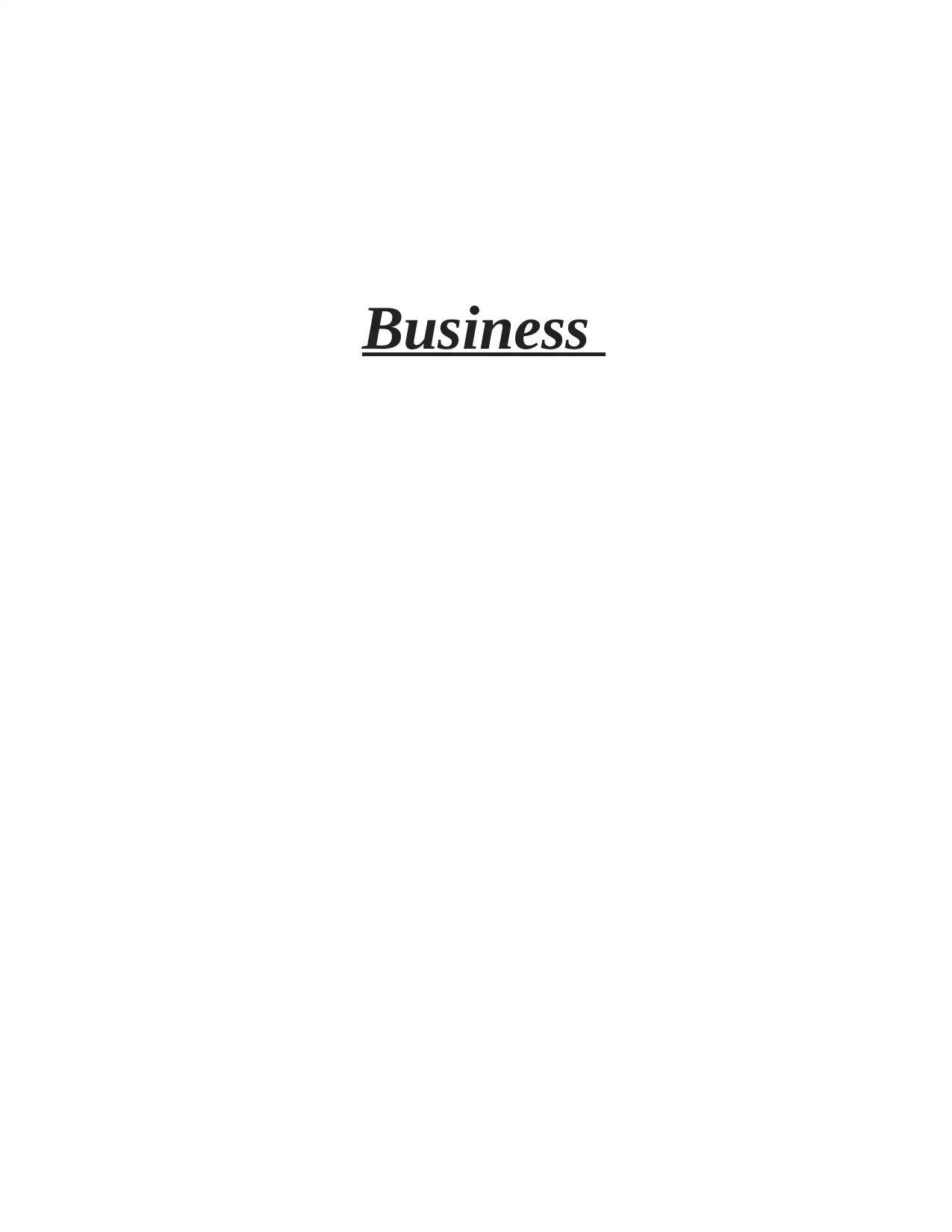
Business
Paraphrase This Document
Need a fresh take? Get an instant paraphrase of this document with our AI Paraphraser
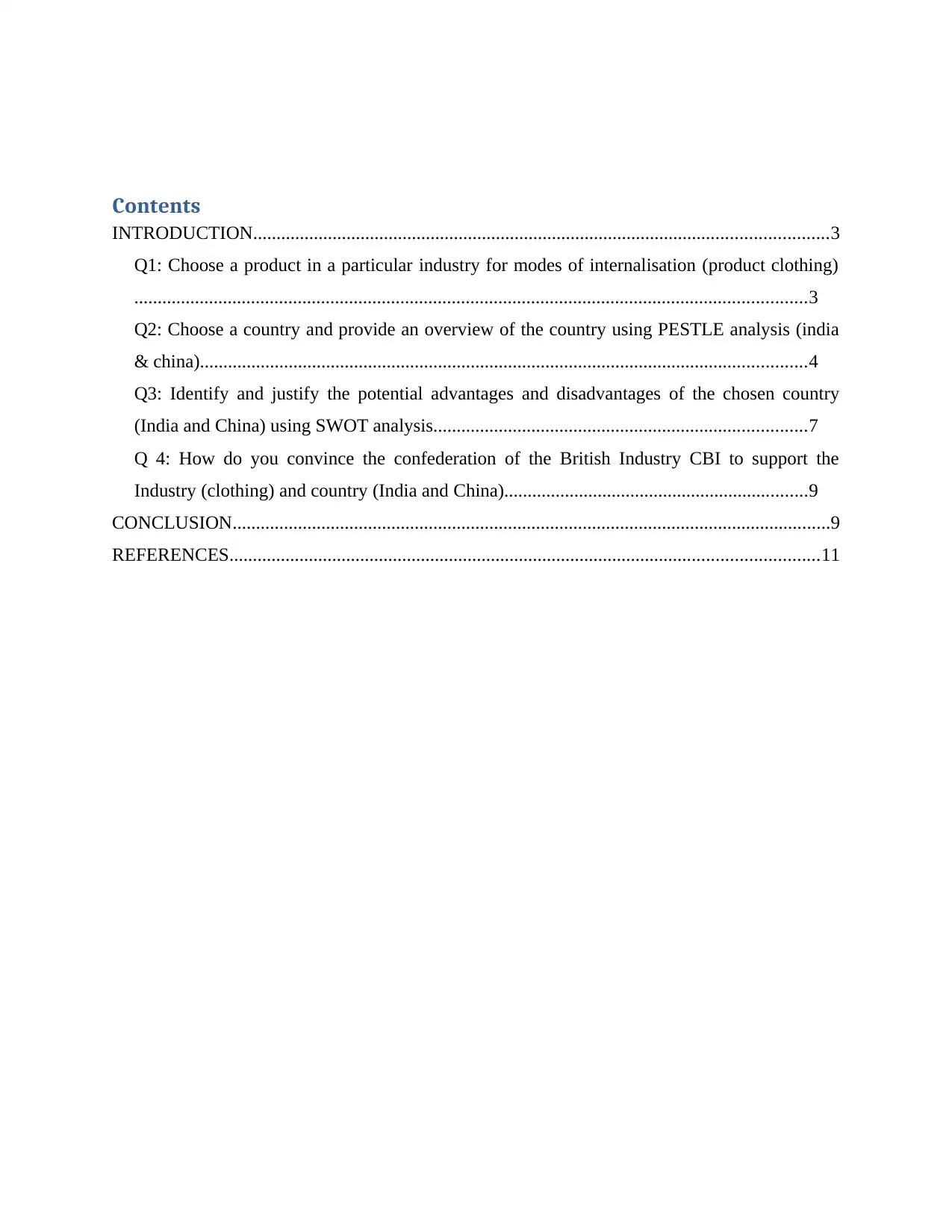
Contents
INTRODUCTION...........................................................................................................................3
Q1: Choose a product in a particular industry for modes of internalisation (product clothing)
................................................................................................................................................3
Q2: Choose a country and provide an overview of the country using PESTLE analysis (india
& china)..................................................................................................................................4
Q3: Identify and justify the potential advantages and disadvantages of the chosen country
(India and China) using SWOT analysis................................................................................7
Q 4: How do you convince the confederation of the British Industry CBI to support the
Industry (clothing) and country (India and China).................................................................9
CONCLUSION................................................................................................................................9
REFERENCES..............................................................................................................................11
INTRODUCTION...........................................................................................................................3
Q1: Choose a product in a particular industry for modes of internalisation (product clothing)
................................................................................................................................................3
Q2: Choose a country and provide an overview of the country using PESTLE analysis (india
& china)..................................................................................................................................4
Q3: Identify and justify the potential advantages and disadvantages of the chosen country
(India and China) using SWOT analysis................................................................................7
Q 4: How do you convince the confederation of the British Industry CBI to support the
Industry (clothing) and country (India and China).................................................................9
CONCLUSION................................................................................................................................9
REFERENCES..............................................................................................................................11
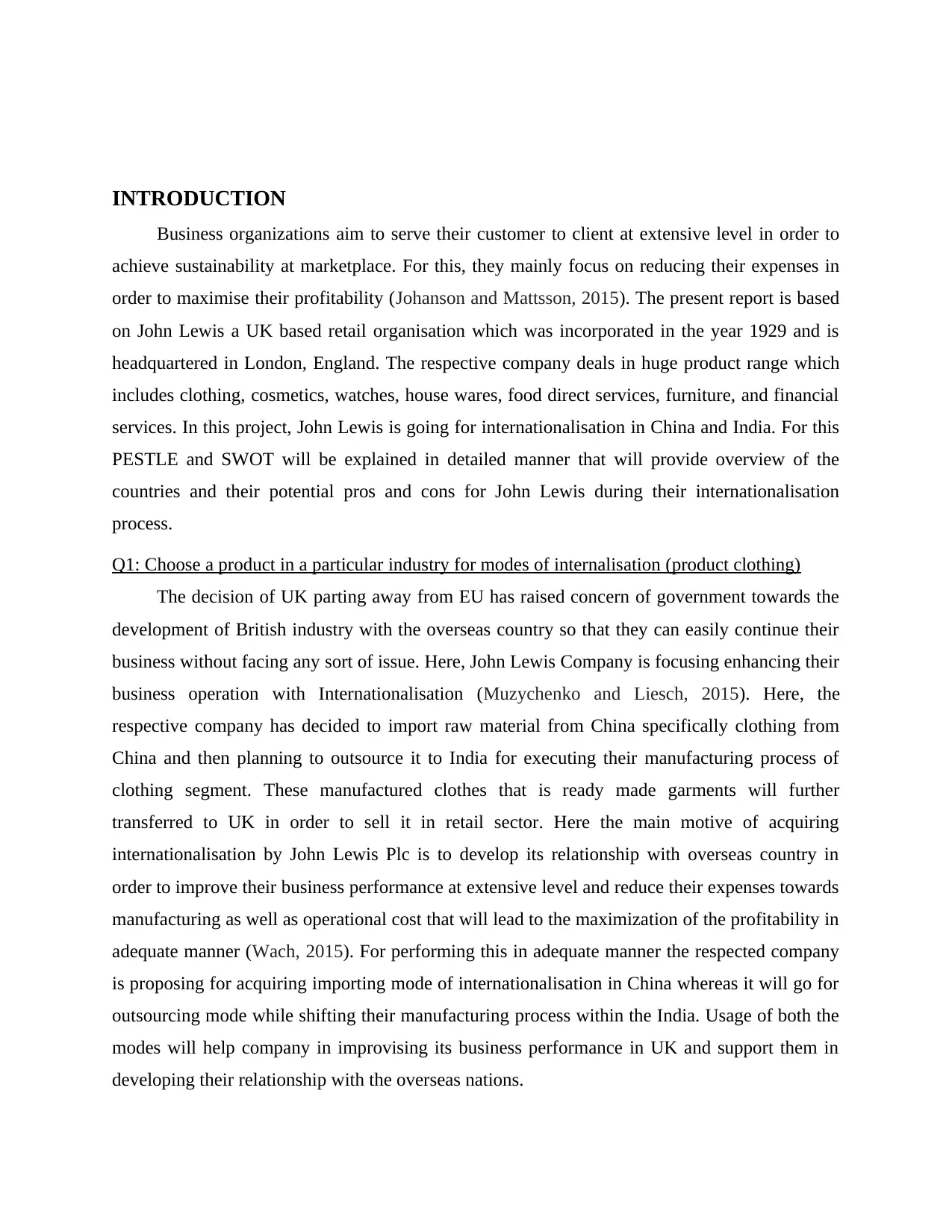
INTRODUCTION
Business organizations aim to serve their customer to client at extensive level in order to
achieve sustainability at marketplace. For this, they mainly focus on reducing their expenses in
order to maximise their profitability (Johanson and Mattsson, 2015). The present report is based
on John Lewis a UK based retail organisation which was incorporated in the year 1929 and is
headquartered in London, England. The respective company deals in huge product range which
includes clothing, cosmetics, watches, house wares, food direct services, furniture, and financial
services. In this project, John Lewis is going for internationalisation in China and India. For this
PESTLE and SWOT will be explained in detailed manner that will provide overview of the
countries and their potential pros and cons for John Lewis during their internationalisation
process.
Q1: Choose a product in a particular industry for modes of internalisation (product clothing)
The decision of UK parting away from EU has raised concern of government towards the
development of British industry with the overseas country so that they can easily continue their
business without facing any sort of issue. Here, John Lewis Company is focusing enhancing their
business operation with Internationalisation (Muzychenko and Liesch, 2015). Here, the
respective company has decided to import raw material from China specifically clothing from
China and then planning to outsource it to India for executing their manufacturing process of
clothing segment. These manufactured clothes that is ready made garments will further
transferred to UK in order to sell it in retail sector. Here the main motive of acquiring
internationalisation by John Lewis Plc is to develop its relationship with overseas country in
order to improve their business performance at extensive level and reduce their expenses towards
manufacturing as well as operational cost that will lead to the maximization of the profitability in
adequate manner (Wach, 2015). For performing this in adequate manner the respected company
is proposing for acquiring importing mode of internationalisation in China whereas it will go for
outsourcing mode while shifting their manufacturing process within the India. Usage of both the
modes will help company in improvising its business performance in UK and support them in
developing their relationship with the overseas nations.
Business organizations aim to serve their customer to client at extensive level in order to
achieve sustainability at marketplace. For this, they mainly focus on reducing their expenses in
order to maximise their profitability (Johanson and Mattsson, 2015). The present report is based
on John Lewis a UK based retail organisation which was incorporated in the year 1929 and is
headquartered in London, England. The respective company deals in huge product range which
includes clothing, cosmetics, watches, house wares, food direct services, furniture, and financial
services. In this project, John Lewis is going for internationalisation in China and India. For this
PESTLE and SWOT will be explained in detailed manner that will provide overview of the
countries and their potential pros and cons for John Lewis during their internationalisation
process.
Q1: Choose a product in a particular industry for modes of internalisation (product clothing)
The decision of UK parting away from EU has raised concern of government towards the
development of British industry with the overseas country so that they can easily continue their
business without facing any sort of issue. Here, John Lewis Company is focusing enhancing their
business operation with Internationalisation (Muzychenko and Liesch, 2015). Here, the
respective company has decided to import raw material from China specifically clothing from
China and then planning to outsource it to India for executing their manufacturing process of
clothing segment. These manufactured clothes that is ready made garments will further
transferred to UK in order to sell it in retail sector. Here the main motive of acquiring
internationalisation by John Lewis Plc is to develop its relationship with overseas country in
order to improve their business performance at extensive level and reduce their expenses towards
manufacturing as well as operational cost that will lead to the maximization of the profitability in
adequate manner (Wach, 2015). For performing this in adequate manner the respected company
is proposing for acquiring importing mode of internationalisation in China whereas it will go for
outsourcing mode while shifting their manufacturing process within the India. Usage of both the
modes will help company in improvising its business performance in UK and support them in
developing their relationship with the overseas nations.
⊘ This is a preview!⊘
Do you want full access?
Subscribe today to unlock all pages.

Trusted by 1+ million students worldwide
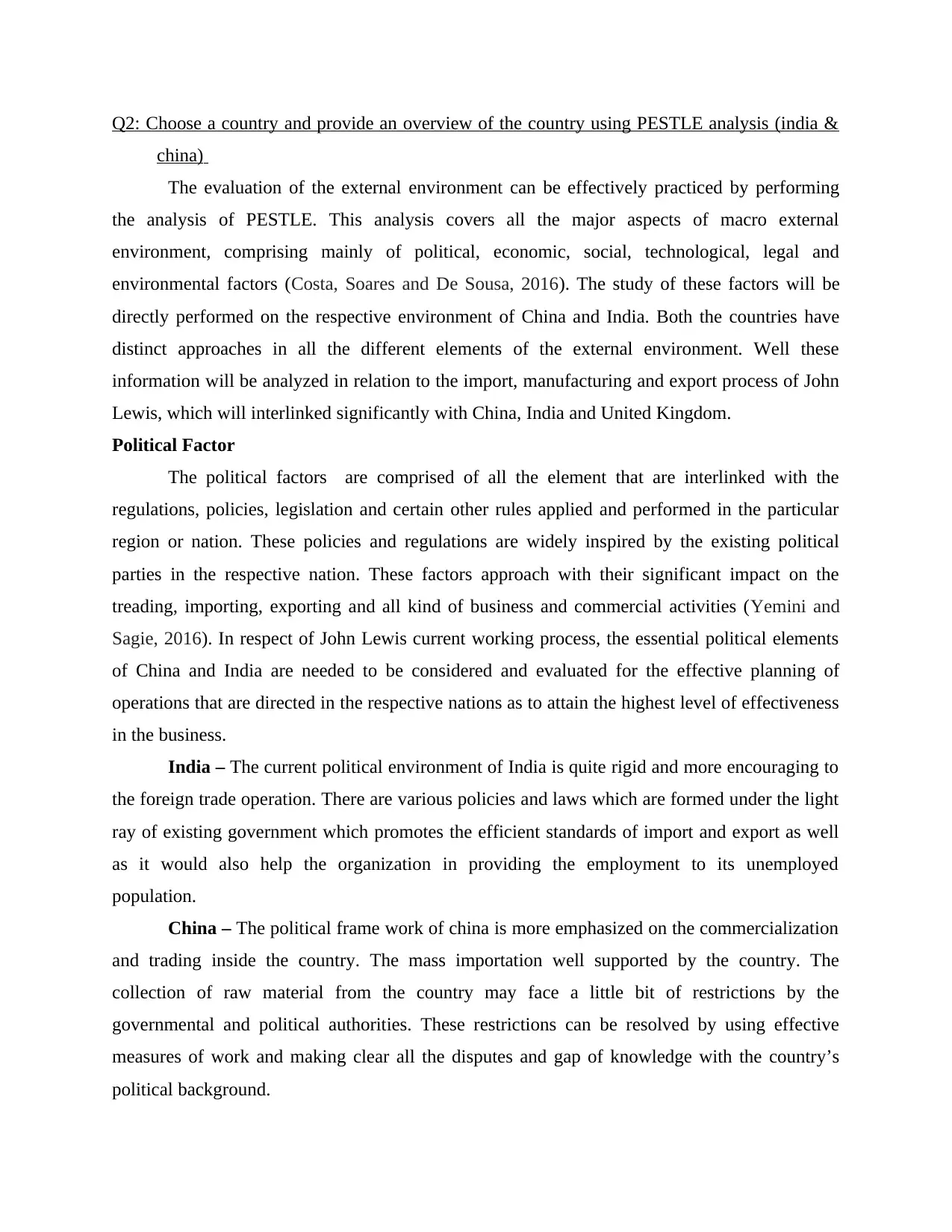
Q2: Choose a country and provide an overview of the country using PESTLE analysis (india &
china)
The evaluation of the external environment can be effectively practiced by performing
the analysis of PESTLE. This analysis covers all the major aspects of macro external
environment, comprising mainly of political, economic, social, technological, legal and
environmental factors (Costa, Soares and De Sousa, 2016). The study of these factors will be
directly performed on the respective environment of China and India. Both the countries have
distinct approaches in all the different elements of the external environment. Well these
information will be analyzed in relation to the import, manufacturing and export process of John
Lewis, which will interlinked significantly with China, India and United Kingdom.
Political Factor
The political factors are comprised of all the element that are interlinked with the
regulations, policies, legislation and certain other rules applied and performed in the particular
region or nation. These policies and regulations are widely inspired by the existing political
parties in the respective nation. These factors approach with their significant impact on the
treading, importing, exporting and all kind of business and commercial activities (Yemini and
Sagie, 2016). In respect of John Lewis current working process, the essential political elements
of China and India are needed to be considered and evaluated for the effective planning of
operations that are directed in the respective nations as to attain the highest level of effectiveness
in the business.
India – The current political environment of India is quite rigid and more encouraging to
the foreign trade operation. There are various policies and laws which are formed under the light
ray of existing government which promotes the efficient standards of import and export as well
as it would also help the organization in providing the employment to its unemployed
population.
China – The political frame work of china is more emphasized on the commercialization
and trading inside the country. The mass importation well supported by the country. The
collection of raw material from the country may face a little bit of restrictions by the
governmental and political authorities. These restrictions can be resolved by using effective
measures of work and making clear all the disputes and gap of knowledge with the country’s
political background.
china)
The evaluation of the external environment can be effectively practiced by performing
the analysis of PESTLE. This analysis covers all the major aspects of macro external
environment, comprising mainly of political, economic, social, technological, legal and
environmental factors (Costa, Soares and De Sousa, 2016). The study of these factors will be
directly performed on the respective environment of China and India. Both the countries have
distinct approaches in all the different elements of the external environment. Well these
information will be analyzed in relation to the import, manufacturing and export process of John
Lewis, which will interlinked significantly with China, India and United Kingdom.
Political Factor
The political factors are comprised of all the element that are interlinked with the
regulations, policies, legislation and certain other rules applied and performed in the particular
region or nation. These policies and regulations are widely inspired by the existing political
parties in the respective nation. These factors approach with their significant impact on the
treading, importing, exporting and all kind of business and commercial activities (Yemini and
Sagie, 2016). In respect of John Lewis current working process, the essential political elements
of China and India are needed to be considered and evaluated for the effective planning of
operations that are directed in the respective nations as to attain the highest level of effectiveness
in the business.
India – The current political environment of India is quite rigid and more encouraging to
the foreign trade operation. There are various policies and laws which are formed under the light
ray of existing government which promotes the efficient standards of import and export as well
as it would also help the organization in providing the employment to its unemployed
population.
China – The political frame work of china is more emphasized on the commercialization
and trading inside the country. The mass importation well supported by the country. The
collection of raw material from the country may face a little bit of restrictions by the
governmental and political authorities. These restrictions can be resolved by using effective
measures of work and making clear all the disputes and gap of knowledge with the country’s
political background.
Paraphrase This Document
Need a fresh take? Get an instant paraphrase of this document with our AI Paraphraser
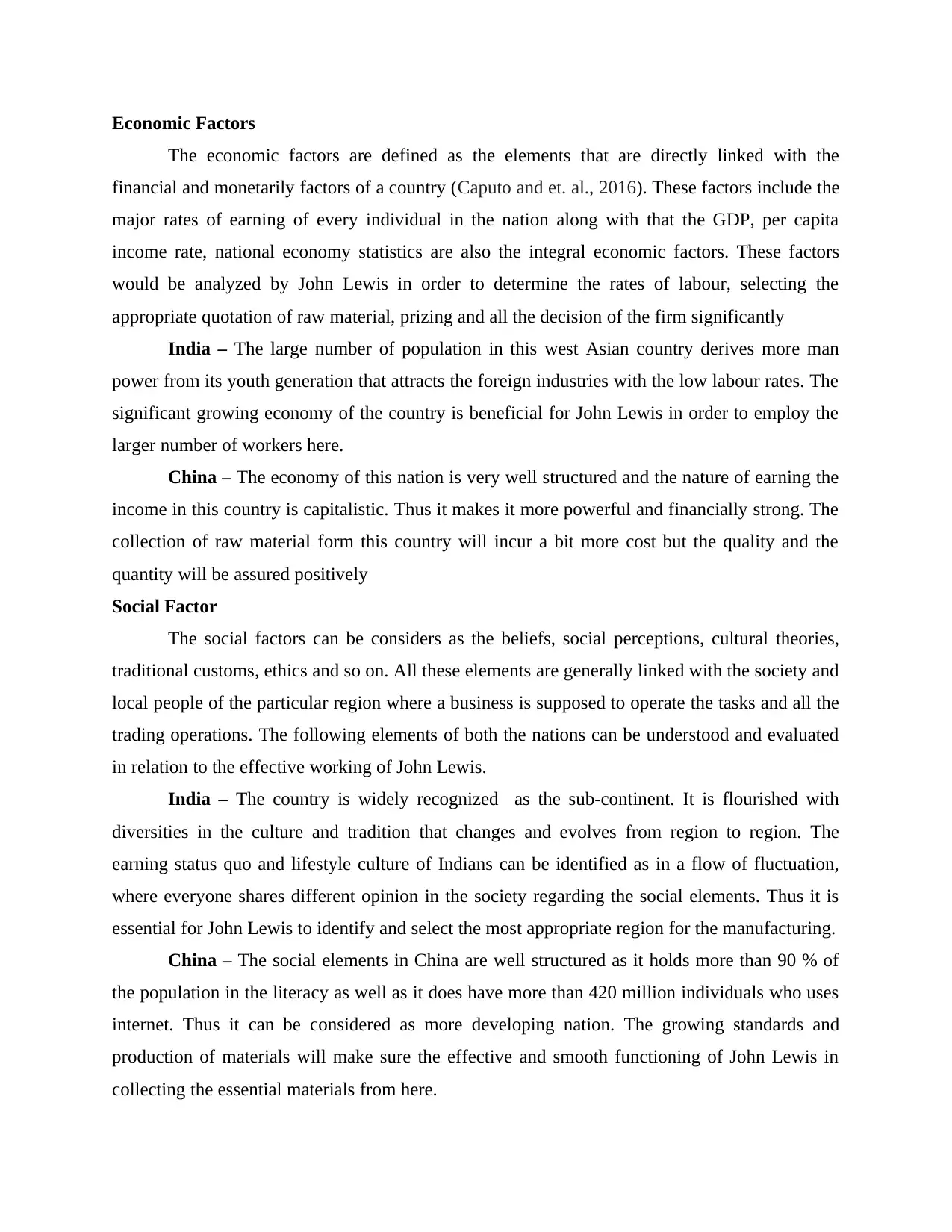
Economic Factors
The economic factors are defined as the elements that are directly linked with the
financial and monetarily factors of a country (Caputo and et. al., 2016). These factors include the
major rates of earning of every individual in the nation along with that the GDP, per capita
income rate, national economy statistics are also the integral economic factors. These factors
would be analyzed by John Lewis in order to determine the rates of labour, selecting the
appropriate quotation of raw material, prizing and all the decision of the firm significantly
India – The large number of population in this west Asian country derives more man
power from its youth generation that attracts the foreign industries with the low labour rates. The
significant growing economy of the country is beneficial for John Lewis in order to employ the
larger number of workers here.
China – The economy of this nation is very well structured and the nature of earning the
income in this country is capitalistic. Thus it makes it more powerful and financially strong. The
collection of raw material form this country will incur a bit more cost but the quality and the
quantity will be assured positively
Social Factor
The social factors can be considers as the beliefs, social perceptions, cultural theories,
traditional customs, ethics and so on. All these elements are generally linked with the society and
local people of the particular region where a business is supposed to operate the tasks and all the
trading operations. The following elements of both the nations can be understood and evaluated
in relation to the effective working of John Lewis.
India – The country is widely recognized as the sub-continent. It is flourished with
diversities in the culture and tradition that changes and evolves from region to region. The
earning status quo and lifestyle culture of Indians can be identified as in a flow of fluctuation,
where everyone shares different opinion in the society regarding the social elements. Thus it is
essential for John Lewis to identify and select the most appropriate region for the manufacturing.
China – The social elements in China are well structured as it holds more than 90 % of
the population in the literacy as well as it does have more than 420 million individuals who uses
internet. Thus it can be considered as more developing nation. The growing standards and
production of materials will make sure the effective and smooth functioning of John Lewis in
collecting the essential materials from here.
The economic factors are defined as the elements that are directly linked with the
financial and monetarily factors of a country (Caputo and et. al., 2016). These factors include the
major rates of earning of every individual in the nation along with that the GDP, per capita
income rate, national economy statistics are also the integral economic factors. These factors
would be analyzed by John Lewis in order to determine the rates of labour, selecting the
appropriate quotation of raw material, prizing and all the decision of the firm significantly
India – The large number of population in this west Asian country derives more man
power from its youth generation that attracts the foreign industries with the low labour rates. The
significant growing economy of the country is beneficial for John Lewis in order to employ the
larger number of workers here.
China – The economy of this nation is very well structured and the nature of earning the
income in this country is capitalistic. Thus it makes it more powerful and financially strong. The
collection of raw material form this country will incur a bit more cost but the quality and the
quantity will be assured positively
Social Factor
The social factors can be considers as the beliefs, social perceptions, cultural theories,
traditional customs, ethics and so on. All these elements are generally linked with the society and
local people of the particular region where a business is supposed to operate the tasks and all the
trading operations. The following elements of both the nations can be understood and evaluated
in relation to the effective working of John Lewis.
India – The country is widely recognized as the sub-continent. It is flourished with
diversities in the culture and tradition that changes and evolves from region to region. The
earning status quo and lifestyle culture of Indians can be identified as in a flow of fluctuation,
where everyone shares different opinion in the society regarding the social elements. Thus it is
essential for John Lewis to identify and select the most appropriate region for the manufacturing.
China – The social elements in China are well structured as it holds more than 90 % of
the population in the literacy as well as it does have more than 420 million individuals who uses
internet. Thus it can be considered as more developing nation. The growing standards and
production of materials will make sure the effective and smooth functioning of John Lewis in
collecting the essential materials from here.
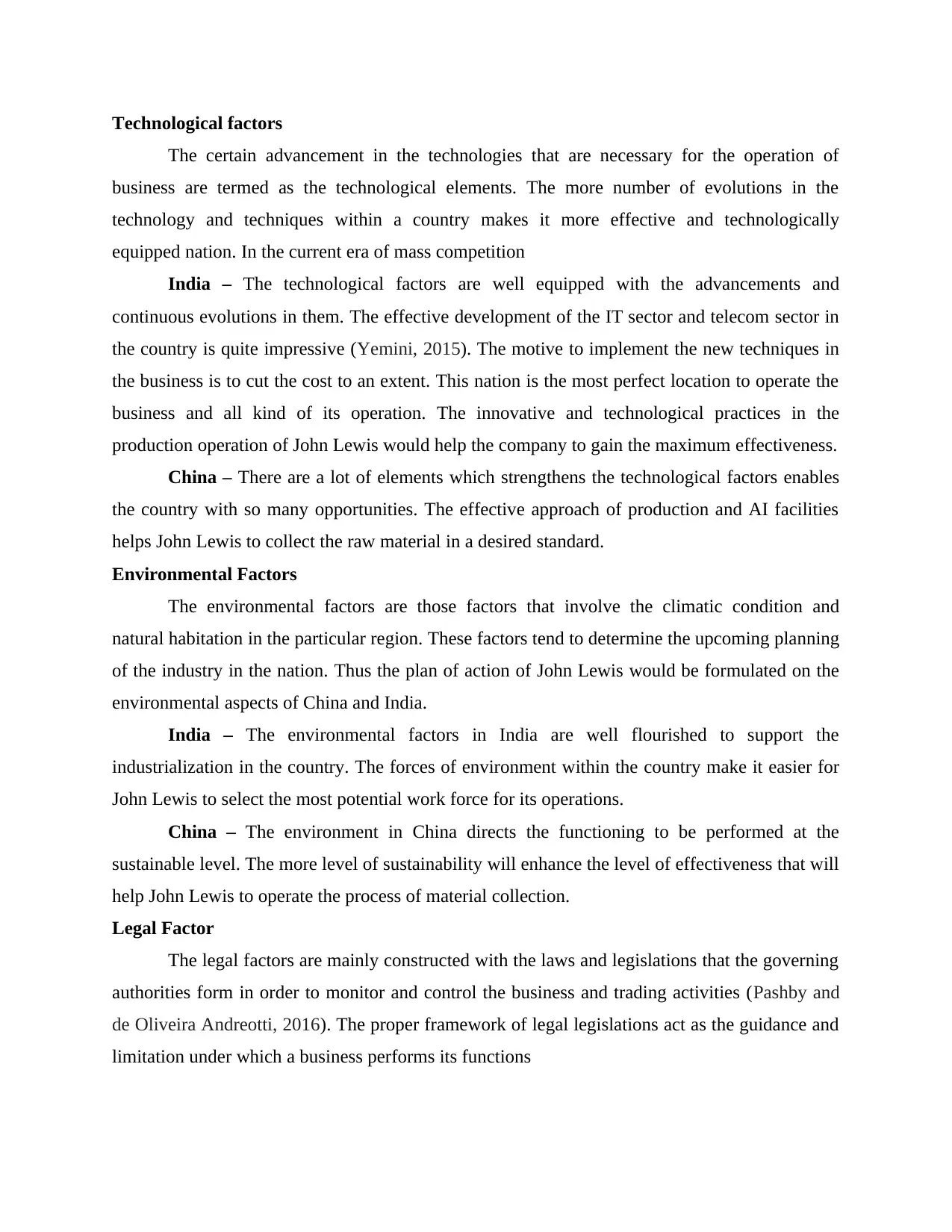
Technological factors
The certain advancement in the technologies that are necessary for the operation of
business are termed as the technological elements. The more number of evolutions in the
technology and techniques within a country makes it more effective and technologically
equipped nation. In the current era of mass competition
India – The technological factors are well equipped with the advancements and
continuous evolutions in them. The effective development of the IT sector and telecom sector in
the country is quite impressive (Yemini, 2015). The motive to implement the new techniques in
the business is to cut the cost to an extent. This nation is the most perfect location to operate the
business and all kind of its operation. The innovative and technological practices in the
production operation of John Lewis would help the company to gain the maximum effectiveness.
China – There are a lot of elements which strengthens the technological factors enables
the country with so many opportunities. The effective approach of production and AI facilities
helps John Lewis to collect the raw material in a desired standard.
Environmental Factors
The environmental factors are those factors that involve the climatic condition and
natural habitation in the particular region. These factors tend to determine the upcoming planning
of the industry in the nation. Thus the plan of action of John Lewis would be formulated on the
environmental aspects of China and India.
India – The environmental factors in India are well flourished to support the
industrialization in the country. The forces of environment within the country make it easier for
John Lewis to select the most potential work force for its operations.
China – The environment in China directs the functioning to be performed at the
sustainable level. The more level of sustainability will enhance the level of effectiveness that will
help John Lewis to operate the process of material collection.
Legal Factor
The legal factors are mainly constructed with the laws and legislations that the governing
authorities form in order to monitor and control the business and trading activities (Pashby and
de Oliveira Andreotti, 2016). The proper framework of legal legislations act as the guidance and
limitation under which a business performs its functions
The certain advancement in the technologies that are necessary for the operation of
business are termed as the technological elements. The more number of evolutions in the
technology and techniques within a country makes it more effective and technologically
equipped nation. In the current era of mass competition
India – The technological factors are well equipped with the advancements and
continuous evolutions in them. The effective development of the IT sector and telecom sector in
the country is quite impressive (Yemini, 2015). The motive to implement the new techniques in
the business is to cut the cost to an extent. This nation is the most perfect location to operate the
business and all kind of its operation. The innovative and technological practices in the
production operation of John Lewis would help the company to gain the maximum effectiveness.
China – There are a lot of elements which strengthens the technological factors enables
the country with so many opportunities. The effective approach of production and AI facilities
helps John Lewis to collect the raw material in a desired standard.
Environmental Factors
The environmental factors are those factors that involve the climatic condition and
natural habitation in the particular region. These factors tend to determine the upcoming planning
of the industry in the nation. Thus the plan of action of John Lewis would be formulated on the
environmental aspects of China and India.
India – The environmental factors in India are well flourished to support the
industrialization in the country. The forces of environment within the country make it easier for
John Lewis to select the most potential work force for its operations.
China – The environment in China directs the functioning to be performed at the
sustainable level. The more level of sustainability will enhance the level of effectiveness that will
help John Lewis to operate the process of material collection.
Legal Factor
The legal factors are mainly constructed with the laws and legislations that the governing
authorities form in order to monitor and control the business and trading activities (Pashby and
de Oliveira Andreotti, 2016). The proper framework of legal legislations act as the guidance and
limitation under which a business performs its functions
⊘ This is a preview!⊘
Do you want full access?
Subscribe today to unlock all pages.

Trusted by 1+ million students worldwide
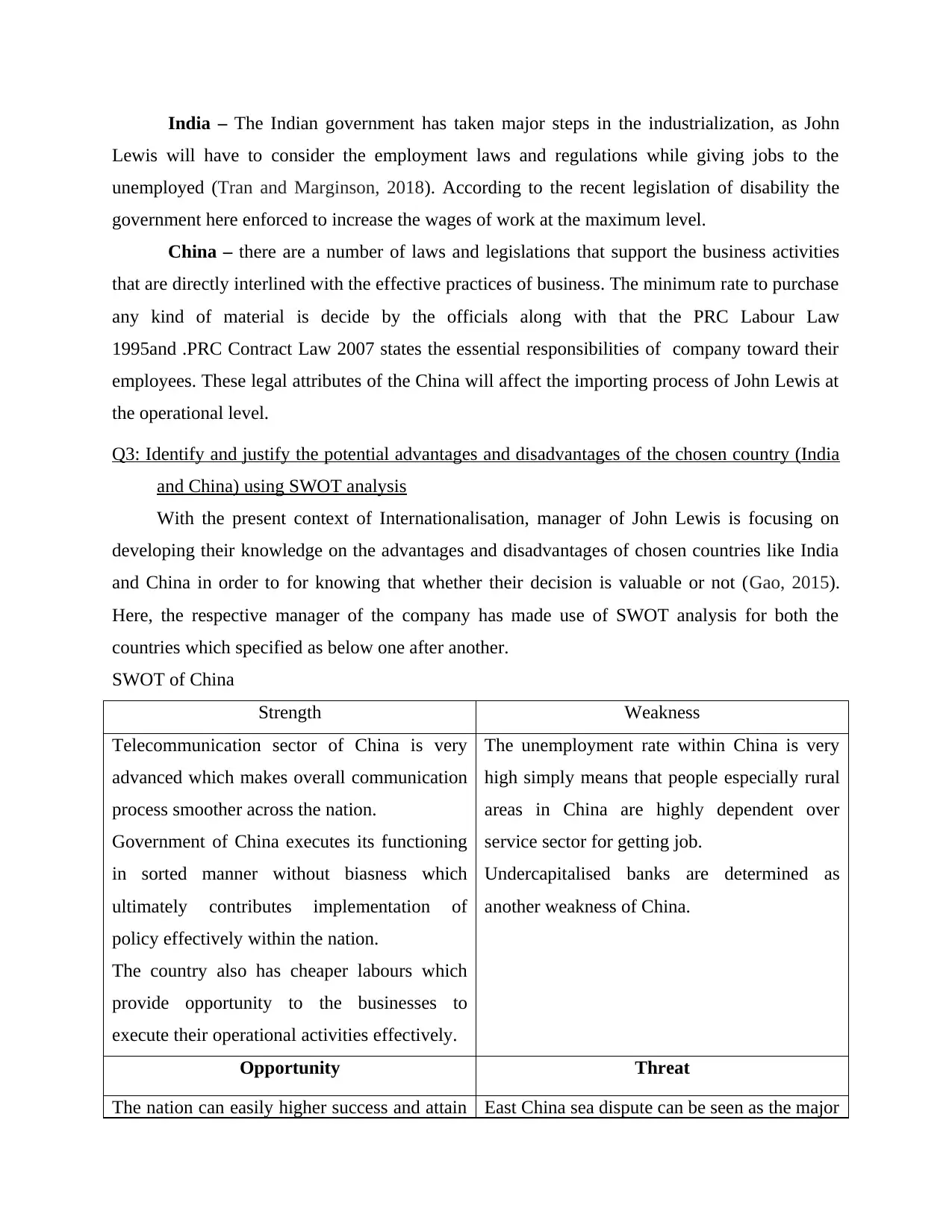
India – The Indian government has taken major steps in the industrialization, as John
Lewis will have to consider the employment laws and regulations while giving jobs to the
unemployed (Tran and Marginson, 2018). According to the recent legislation of disability the
government here enforced to increase the wages of work at the maximum level.
China – there are a number of laws and legislations that support the business activities
that are directly interlined with the effective practices of business. The minimum rate to purchase
any kind of material is decide by the officials along with that the PRC Labour Law
1995and .PRC Contract Law 2007 states the essential responsibilities of company toward their
employees. These legal attributes of the China will affect the importing process of John Lewis at
the operational level.
Q3: Identify and justify the potential advantages and disadvantages of the chosen country (India
and China) using SWOT analysis
With the present context of Internationalisation, manager of John Lewis is focusing on
developing their knowledge on the advantages and disadvantages of chosen countries like India
and China in order to for knowing that whether their decision is valuable or not (Gao, 2015).
Here, the respective manager of the company has made use of SWOT analysis for both the
countries which specified as below one after another.
SWOT of China
Strength Weakness
Telecommunication sector of China is very
advanced which makes overall communication
process smoother across the nation.
Government of China executes its functioning
in sorted manner without biasness which
ultimately contributes implementation of
policy effectively within the nation.
The country also has cheaper labours which
provide opportunity to the businesses to
execute their operational activities effectively.
The unemployment rate within China is very
high simply means that people especially rural
areas in China are highly dependent over
service sector for getting job.
Undercapitalised banks are determined as
another weakness of China.
Opportunity Threat
The nation can easily higher success and attain East China sea dispute can be seen as the major
Lewis will have to consider the employment laws and regulations while giving jobs to the
unemployed (Tran and Marginson, 2018). According to the recent legislation of disability the
government here enforced to increase the wages of work at the maximum level.
China – there are a number of laws and legislations that support the business activities
that are directly interlined with the effective practices of business. The minimum rate to purchase
any kind of material is decide by the officials along with that the PRC Labour Law
1995and .PRC Contract Law 2007 states the essential responsibilities of company toward their
employees. These legal attributes of the China will affect the importing process of John Lewis at
the operational level.
Q3: Identify and justify the potential advantages and disadvantages of the chosen country (India
and China) using SWOT analysis
With the present context of Internationalisation, manager of John Lewis is focusing on
developing their knowledge on the advantages and disadvantages of chosen countries like India
and China in order to for knowing that whether their decision is valuable or not (Gao, 2015).
Here, the respective manager of the company has made use of SWOT analysis for both the
countries which specified as below one after another.
SWOT of China
Strength Weakness
Telecommunication sector of China is very
advanced which makes overall communication
process smoother across the nation.
Government of China executes its functioning
in sorted manner without biasness which
ultimately contributes implementation of
policy effectively within the nation.
The country also has cheaper labours which
provide opportunity to the businesses to
execute their operational activities effectively.
The unemployment rate within China is very
high simply means that people especially rural
areas in China are highly dependent over
service sector for getting job.
Undercapitalised banks are determined as
another weakness of China.
Opportunity Threat
The nation can easily higher success and attain East China sea dispute can be seen as the major
Paraphrase This Document
Need a fresh take? Get an instant paraphrase of this document with our AI Paraphraser
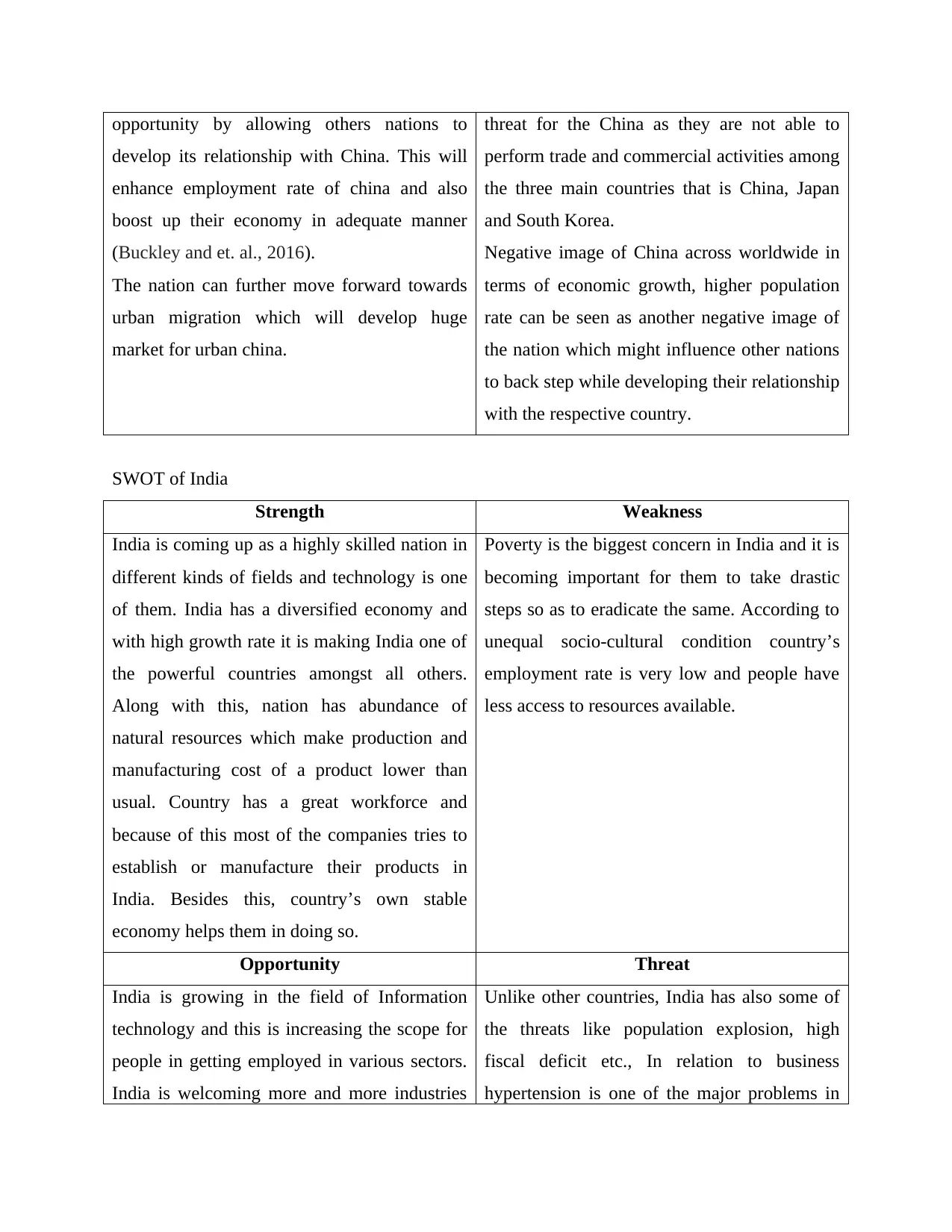
opportunity by allowing others nations to
develop its relationship with China. This will
enhance employment rate of china and also
boost up their economy in adequate manner
(Buckley and et. al., 2016).
The nation can further move forward towards
urban migration which will develop huge
market for urban china.
threat for the China as they are not able to
perform trade and commercial activities among
the three main countries that is China, Japan
and South Korea.
Negative image of China across worldwide in
terms of economic growth, higher population
rate can be seen as another negative image of
the nation which might influence other nations
to back step while developing their relationship
with the respective country.
SWOT of India
Strength Weakness
India is coming up as a highly skilled nation in
different kinds of fields and technology is one
of them. India has a diversified economy and
with high growth rate it is making India one of
the powerful countries amongst all others.
Along with this, nation has abundance of
natural resources which make production and
manufacturing cost of a product lower than
usual. Country has a great workforce and
because of this most of the companies tries to
establish or manufacture their products in
India. Besides this, country’s own stable
economy helps them in doing so.
Poverty is the biggest concern in India and it is
becoming important for them to take drastic
steps so as to eradicate the same. According to
unequal socio-cultural condition country’s
employment rate is very low and people have
less access to resources available.
Opportunity Threat
India is growing in the field of Information
technology and this is increasing the scope for
people in getting employed in various sectors.
India is welcoming more and more industries
Unlike other countries, India has also some of
the threats like population explosion, high
fiscal deficit etc., In relation to business
hypertension is one of the major problems in
develop its relationship with China. This will
enhance employment rate of china and also
boost up their economy in adequate manner
(Buckley and et. al., 2016).
The nation can further move forward towards
urban migration which will develop huge
market for urban china.
threat for the China as they are not able to
perform trade and commercial activities among
the three main countries that is China, Japan
and South Korea.
Negative image of China across worldwide in
terms of economic growth, higher population
rate can be seen as another negative image of
the nation which might influence other nations
to back step while developing their relationship
with the respective country.
SWOT of India
Strength Weakness
India is coming up as a highly skilled nation in
different kinds of fields and technology is one
of them. India has a diversified economy and
with high growth rate it is making India one of
the powerful countries amongst all others.
Along with this, nation has abundance of
natural resources which make production and
manufacturing cost of a product lower than
usual. Country has a great workforce and
because of this most of the companies tries to
establish or manufacture their products in
India. Besides this, country’s own stable
economy helps them in doing so.
Poverty is the biggest concern in India and it is
becoming important for them to take drastic
steps so as to eradicate the same. According to
unequal socio-cultural condition country’s
employment rate is very low and people have
less access to resources available.
Opportunity Threat
India is growing in the field of Information
technology and this is increasing the scope for
people in getting employed in various sectors.
India is welcoming more and more industries
Unlike other countries, India has also some of
the threats like population explosion, high
fiscal deficit etc., In relation to business
hypertension is one of the major problems in
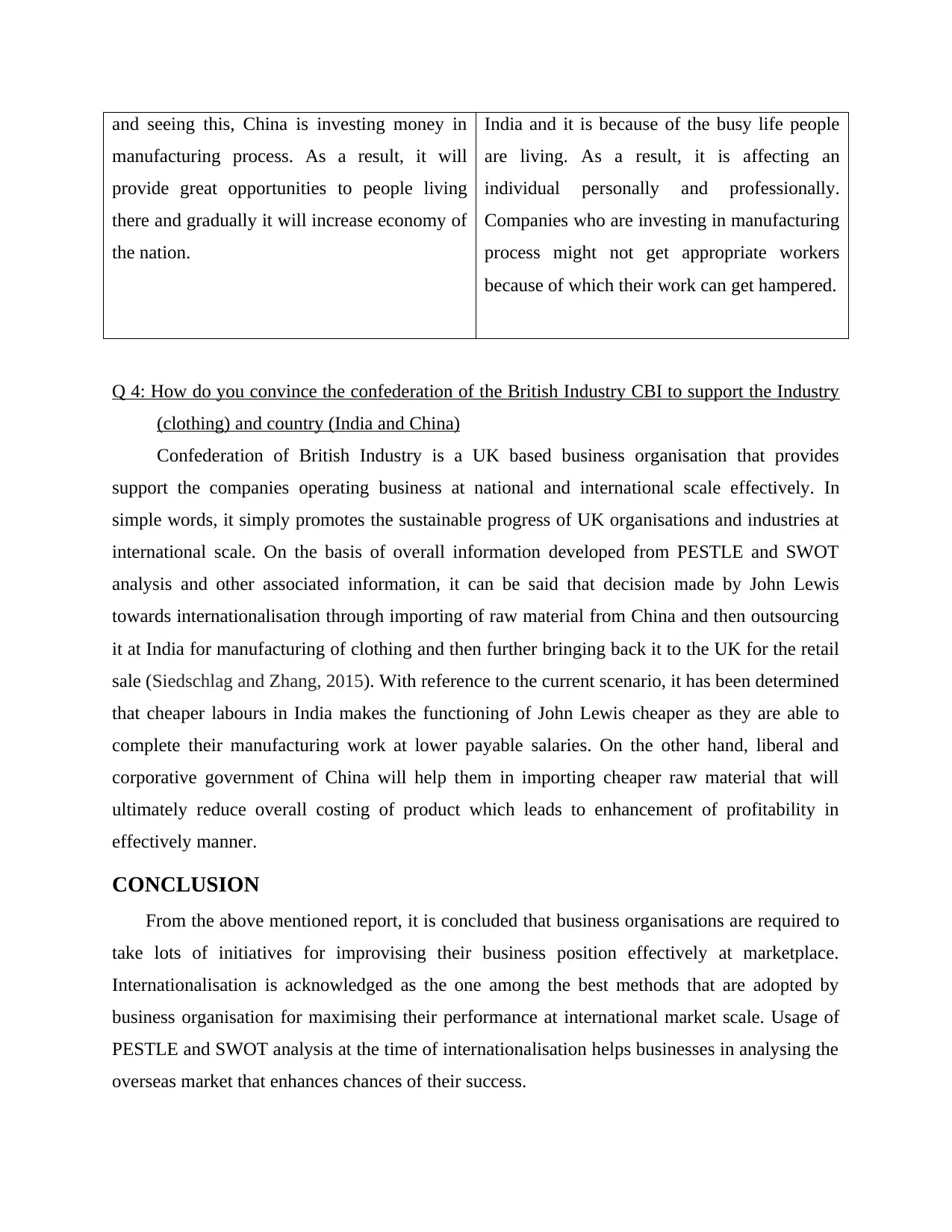
and seeing this, China is investing money in
manufacturing process. As a result, it will
provide great opportunities to people living
there and gradually it will increase economy of
the nation.
India and it is because of the busy life people
are living. As a result, it is affecting an
individual personally and professionally.
Companies who are investing in manufacturing
process might not get appropriate workers
because of which their work can get hampered.
Q 4: How do you convince the confederation of the British Industry CBI to support the Industry
(clothing) and country (India and China)
Confederation of British Industry is a UK based business organisation that provides
support the companies operating business at national and international scale effectively. In
simple words, it simply promotes the sustainable progress of UK organisations and industries at
international scale. On the basis of overall information developed from PESTLE and SWOT
analysis and other associated information, it can be said that decision made by John Lewis
towards internationalisation through importing of raw material from China and then outsourcing
it at India for manufacturing of clothing and then further bringing back it to the UK for the retail
sale (Siedschlag and Zhang, 2015). With reference to the current scenario, it has been determined
that cheaper labours in India makes the functioning of John Lewis cheaper as they are able to
complete their manufacturing work at lower payable salaries. On the other hand, liberal and
corporative government of China will help them in importing cheaper raw material that will
ultimately reduce overall costing of product which leads to enhancement of profitability in
effectively manner.
CONCLUSION
From the above mentioned report, it is concluded that business organisations are required to
take lots of initiatives for improvising their business position effectively at marketplace.
Internationalisation is acknowledged as the one among the best methods that are adopted by
business organisation for maximising their performance at international market scale. Usage of
PESTLE and SWOT analysis at the time of internationalisation helps businesses in analysing the
overseas market that enhances chances of their success.
manufacturing process. As a result, it will
provide great opportunities to people living
there and gradually it will increase economy of
the nation.
India and it is because of the busy life people
are living. As a result, it is affecting an
individual personally and professionally.
Companies who are investing in manufacturing
process might not get appropriate workers
because of which their work can get hampered.
Q 4: How do you convince the confederation of the British Industry CBI to support the Industry
(clothing) and country (India and China)
Confederation of British Industry is a UK based business organisation that provides
support the companies operating business at national and international scale effectively. In
simple words, it simply promotes the sustainable progress of UK organisations and industries at
international scale. On the basis of overall information developed from PESTLE and SWOT
analysis and other associated information, it can be said that decision made by John Lewis
towards internationalisation through importing of raw material from China and then outsourcing
it at India for manufacturing of clothing and then further bringing back it to the UK for the retail
sale (Siedschlag and Zhang, 2015). With reference to the current scenario, it has been determined
that cheaper labours in India makes the functioning of John Lewis cheaper as they are able to
complete their manufacturing work at lower payable salaries. On the other hand, liberal and
corporative government of China will help them in importing cheaper raw material that will
ultimately reduce overall costing of product which leads to enhancement of profitability in
effectively manner.
CONCLUSION
From the above mentioned report, it is concluded that business organisations are required to
take lots of initiatives for improvising their business position effectively at marketplace.
Internationalisation is acknowledged as the one among the best methods that are adopted by
business organisation for maximising their performance at international market scale. Usage of
PESTLE and SWOT analysis at the time of internationalisation helps businesses in analysing the
overseas market that enhances chances of their success.
⊘ This is a preview!⊘
Do you want full access?
Subscribe today to unlock all pages.

Trusted by 1+ million students worldwide

Paraphrase This Document
Need a fresh take? Get an instant paraphrase of this document with our AI Paraphraser
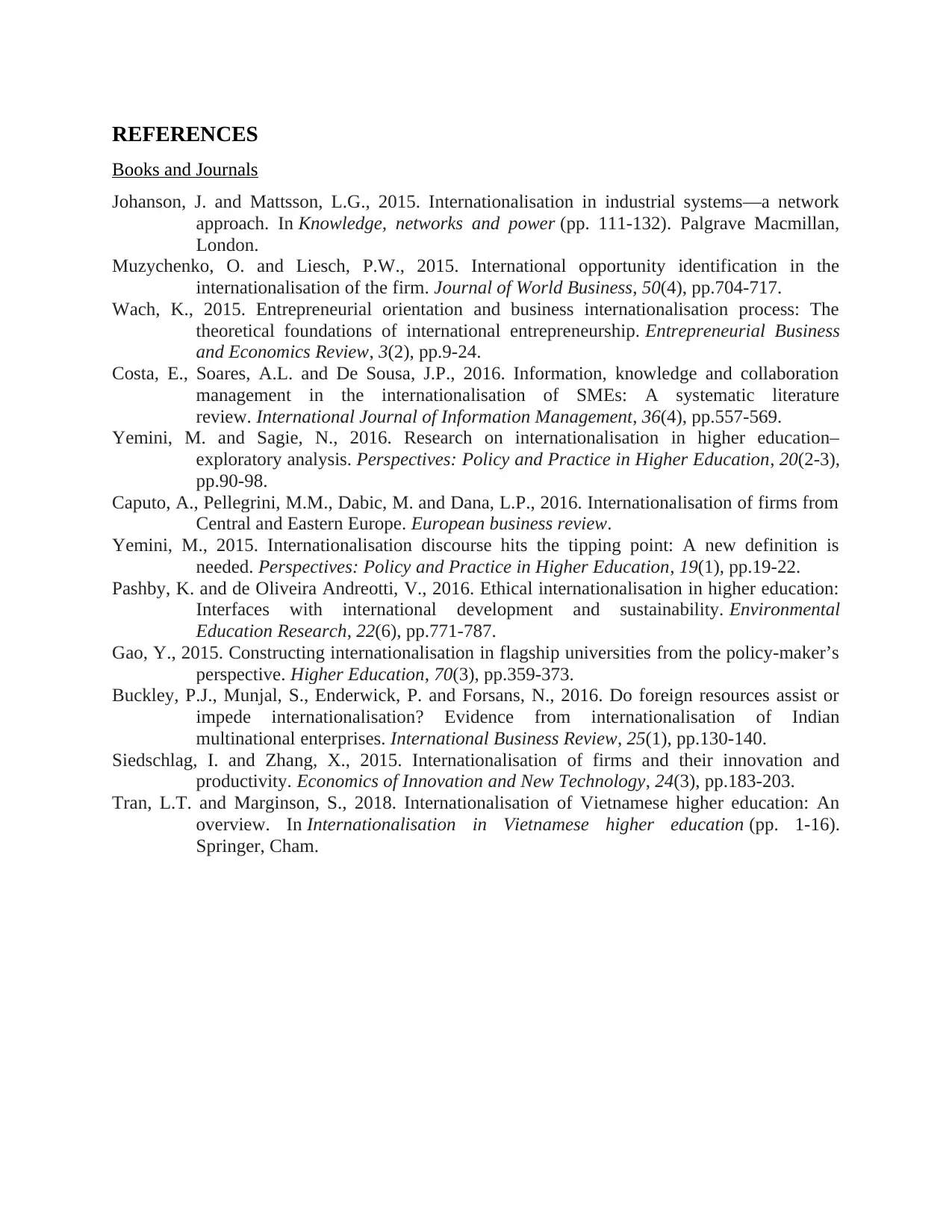
REFERENCES
Books and Journals
Johanson, J. and Mattsson, L.G., 2015. Internationalisation in industrial systems—a network
approach. In Knowledge, networks and power (pp. 111-132). Palgrave Macmillan,
London.
Muzychenko, O. and Liesch, P.W., 2015. International opportunity identification in the
internationalisation of the firm. Journal of World Business, 50(4), pp.704-717.
Wach, K., 2015. Entrepreneurial orientation and business internationalisation process: The
theoretical foundations of international entrepreneurship. Entrepreneurial Business
and Economics Review, 3(2), pp.9-24.
Costa, E., Soares, A.L. and De Sousa, J.P., 2016. Information, knowledge and collaboration
management in the internationalisation of SMEs: A systematic literature
review. International Journal of Information Management, 36(4), pp.557-569.
Yemini, M. and Sagie, N., 2016. Research on internationalisation in higher education–
exploratory analysis. Perspectives: Policy and Practice in Higher Education, 20(2-3),
pp.90-98.
Caputo, A., Pellegrini, M.M., Dabic, M. and Dana, L.P., 2016. Internationalisation of firms from
Central and Eastern Europe. European business review.
Yemini, M., 2015. Internationalisation discourse hits the tipping point: A new definition is
needed. Perspectives: Policy and Practice in Higher Education, 19(1), pp.19-22.
Pashby, K. and de Oliveira Andreotti, V., 2016. Ethical internationalisation in higher education:
Interfaces with international development and sustainability. Environmental
Education Research, 22(6), pp.771-787.
Gao, Y., 2015. Constructing internationalisation in flagship universities from the policy-maker’s
perspective. Higher Education, 70(3), pp.359-373.
Buckley, P.J., Munjal, S., Enderwick, P. and Forsans, N., 2016. Do foreign resources assist or
impede internationalisation? Evidence from internationalisation of Indian
multinational enterprises. International Business Review, 25(1), pp.130-140.
Siedschlag, I. and Zhang, X., 2015. Internationalisation of firms and their innovation and
productivity. Economics of Innovation and New Technology, 24(3), pp.183-203.
Tran, L.T. and Marginson, S., 2018. Internationalisation of Vietnamese higher education: An
overview. In Internationalisation in Vietnamese higher education (pp. 1-16).
Springer, Cham.
Books and Journals
Johanson, J. and Mattsson, L.G., 2015. Internationalisation in industrial systems—a network
approach. In Knowledge, networks and power (pp. 111-132). Palgrave Macmillan,
London.
Muzychenko, O. and Liesch, P.W., 2015. International opportunity identification in the
internationalisation of the firm. Journal of World Business, 50(4), pp.704-717.
Wach, K., 2015. Entrepreneurial orientation and business internationalisation process: The
theoretical foundations of international entrepreneurship. Entrepreneurial Business
and Economics Review, 3(2), pp.9-24.
Costa, E., Soares, A.L. and De Sousa, J.P., 2016. Information, knowledge and collaboration
management in the internationalisation of SMEs: A systematic literature
review. International Journal of Information Management, 36(4), pp.557-569.
Yemini, M. and Sagie, N., 2016. Research on internationalisation in higher education–
exploratory analysis. Perspectives: Policy and Practice in Higher Education, 20(2-3),
pp.90-98.
Caputo, A., Pellegrini, M.M., Dabic, M. and Dana, L.P., 2016. Internationalisation of firms from
Central and Eastern Europe. European business review.
Yemini, M., 2015. Internationalisation discourse hits the tipping point: A new definition is
needed. Perspectives: Policy and Practice in Higher Education, 19(1), pp.19-22.
Pashby, K. and de Oliveira Andreotti, V., 2016. Ethical internationalisation in higher education:
Interfaces with international development and sustainability. Environmental
Education Research, 22(6), pp.771-787.
Gao, Y., 2015. Constructing internationalisation in flagship universities from the policy-maker’s
perspective. Higher Education, 70(3), pp.359-373.
Buckley, P.J., Munjal, S., Enderwick, P. and Forsans, N., 2016. Do foreign resources assist or
impede internationalisation? Evidence from internationalisation of Indian
multinational enterprises. International Business Review, 25(1), pp.130-140.
Siedschlag, I. and Zhang, X., 2015. Internationalisation of firms and their innovation and
productivity. Economics of Innovation and New Technology, 24(3), pp.183-203.
Tran, L.T. and Marginson, S., 2018. Internationalisation of Vietnamese higher education: An
overview. In Internationalisation in Vietnamese higher education (pp. 1-16).
Springer, Cham.
1 out of 11
Related Documents
Your All-in-One AI-Powered Toolkit for Academic Success.
+13062052269
info@desklib.com
Available 24*7 on WhatsApp / Email
![[object Object]](/_next/static/media/star-bottom.7253800d.svg)
Unlock your academic potential
Copyright © 2020–2025 A2Z Services. All Rights Reserved. Developed and managed by ZUCOL.




